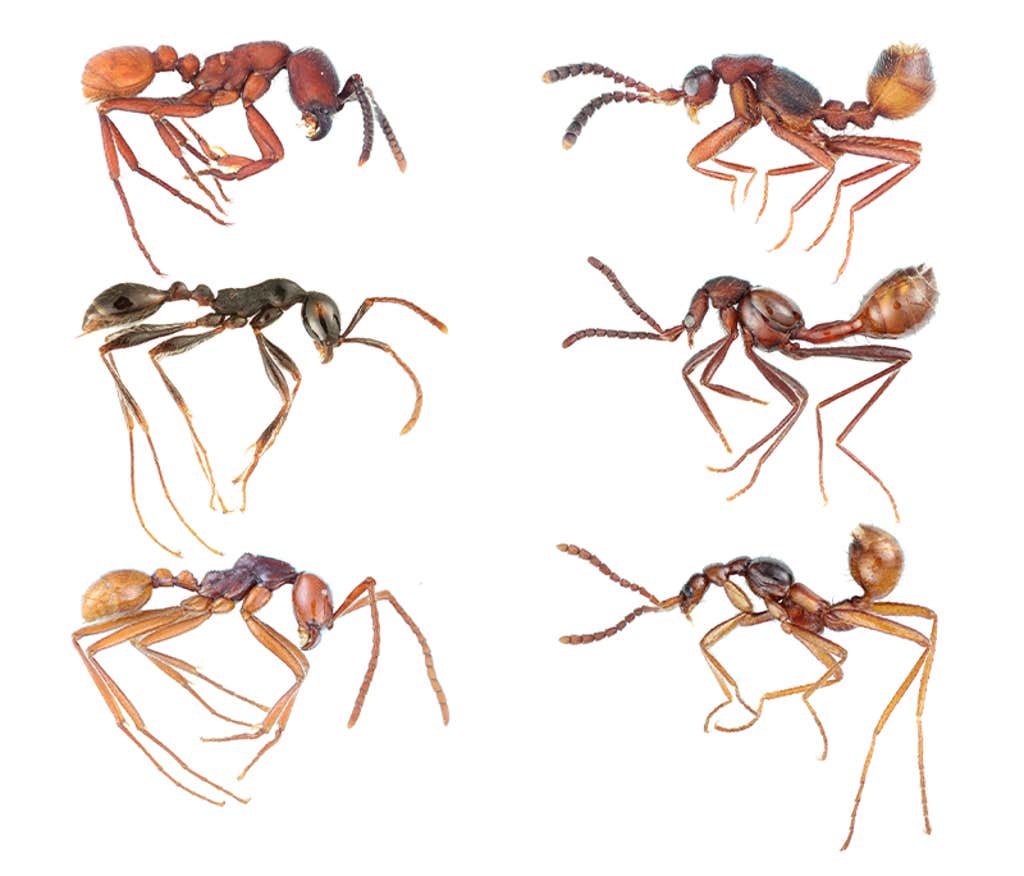Rove beetles are masters of mimicry. They’re not ants—but tell that to the ants.
Some are near-perfect ant-doppelgangers, with bodies that look uncannily like ant bodies: narrow waists, elongated limbs, and elbowed antennae. Others have adopted ant-like behaviors, such as grooming or participating in raids. Still others give off the same chemical signals that ants do. The result is that the ants are deceived into treating the beetles as their own, allowing them to infiltrate ant colonies for food—sometimes the beetles eat the ants’ young—and other resources.
Even more surprising is that at least a dozen distinct lineages of these beetles independently evolved the ability to mimic the ants across many millions of years, a phenomenon known as convergent evolution. Joseph Parker, an evolutionary biologist at the California Institute of Technology and MacArthur grantee, has spent his career investigating why. What he is finding has implications for one of biology’s great debates: How much of evolution is a predictable response to external circumstances, and how much is driven by chance?
This is not a trivial group of organisms.
Parker’s fascination with rove beetles began early. He collected bugs around his home in Wales when he was a kid, and the rove beetles’ diversity caught his attention. Later, as an undergraduate, he spent time in a laboratory at the National History Museum in London helping to construct the evolutionary trees of beetles. That’s when he realized that so many of the rove beetle species that live symbiotically with ants are scattered across the evolutionary tree, revealing multiple independent transitions from free-living to symbiotic lifestyles.
“This is not a trivial group of organisms,” says Parker. There are close to 67,000 described species of rove beetles. “I’m interested in these beetles because they provide a paradigm for understanding how new kinds of ecological relationships between species emerge during evolution,” he says. Typically, convergent evolution shapes a single characteristic—like the shape of bat and bird wings or protective spikes in porcupines and echidnas—whereas the rove beetles independently evolved many different ant-like features over time. “It’s very unusual,” Parker says.

To better understand the point of origin for all of these different adaptations, Parker recently looked closely at the beetles’ chemical defense system. All lineages of rove beetles have an abdominal gland that produces chemical secretions. In some species, this gland emits a repellent to ward off predators, but in others, it produces substances that intoxicate ants, rendering them defenseless. Over time, Parker found, the gland’s purpose evolved from a defense mechanism to a tool for infiltration, enabling the beetles to manipulate their ant hosts. Once the beetles gained access to the ant nests, they evolved the other adaptations that enabled the ant-beetle symbiosis. In some cases, they later lost the initial adaptation that allowed them to mimic the ants’ chemical signals in the first place.
“The gland itself acted as this reprogrammable device,” says Parker. His work reveals the common pathways life can take when different species face similar ecological pressures. “These beetles keep finding the same solution,” Parker says. “It tells us that long-term, highly predictable phenotypic evolution is absolutely possible.”
Daniel Kronauer, an ant researcher at Rockefeller University, notes that a specific set of initial conditions were crucial to setting the beetles on their evolutionary path. “While these findings show that evolution can be remarkably deterministic in some contexts, it’s important to note that the initial conditions—like the beetles’ unique chemical glands—play a crucial role in setting this pathway in motion. Without these predisposing traits, the outcomes might be very different.”
The beetles stand as a testament to nature’s capacity for both re-invention and consistency. ![]()
Lead image: khlungcenter / Shutterstock
































